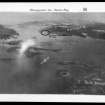Houton, Seaplane Base
Seaplane Base (First World War)
Site Name Houton, Seaplane Base
Classification Seaplane Base (First World War)
Alternative Name(s) Houton Bay Seplane Station
Canmore ID 95065
Site Number HY30SW 42
NGR HY 3201 0390
NGR Description Centred HY 3201 0390 and HY 312 039
Datum OSGB36 - NGR
Permalink http://canmore.org.uk/site/95065
- Council Orkney Islands
- Parish Orphir
- Former Region Orkney Islands Area
- Former District Orkney
- Former County Orkney
Houton Bay was the location of a seaplane base, kite balloon base and wireless telegraphy station during the First World War. The whole base covered an area of 61 hectares surrounding the sheltered anchorage provided by Houton Bay, and a further 12.5 hectares on Holm of Houton, the island that narrows the entrance to the bay. A further 2.4 hectares was occupied by the telegraphy station.
The seaplane base was established in 1917 for long-range anti-submarine patrols on a site where huts and a slipway for seaplanes had already been built in 1916. At the time of the RAF aerodrome survey in the autumn of 1918 some of the buildings of the base, although it was fully operational, were still being built. There were three seaplane sheds, two 61m by 30.5m and one 55m by 18m, two slipways and a full range of workshops and stores for an operational base. One of the buildings housed the wireless station and a radio direction finder. The seaplane base’s technical buildings were arranged around the NE arc of the bay. In the autumn of 1918 there were 24 seaplanes on the base. The 1918 establishment of the base was 350 officers and men, who were accommodated in a hutted camp at the eastern edge of the site.
The kite balloon station occupied the western part of the site. Kite balloons were towed behind warships at a height of about 1000m to provide a raised platform for observation. The Houton Bay station had ten canvas balloon sheds, one for each of its balloons. The sheds measured 30.5m by 11m. The kite balloon station had its own workshops, stores and repair shop. The 264 officers and men of the balloon base were accommodated in a hutted camp to the east of the balloon sheds.
The base was closed and sold in the early 1920s
None of the buildings of the station survive, but the modern field pattern reflects the location of some building complexes, for example the location of the balloon sheds and two of the seaplane sheds. Building platforms and concrete posts are visible. The two seaplane slipways and a third pier, to the west, marked on the RAF survey map, survive, albeit rather broken up.
Information from HS/RCAHMS World War One Audit Project (GJB) 31 May 2013
HY30SW 42 Centred 3201 0390 and 312 039
See also HY30SW 41.00 for site of First World Military camp site with Second World War Anti-aircraft Battery built at same location.
One of two seaplane bases built in Orkney in the First World War, one in Stenness (HY31SW 71), the other Orphir. The Stenness Loch base proved too shallow and too exposed for a seaplane base and eventually the more sheltered base at Houton on the edge of Scapa Flow was favoured.
Originally intended only as a repair and maintainance base, Houton, when fully developed had slipways, hangars, concrete aprons, repair shops, its own generating plant and accommodation for a staff of 600. A kite balloon station was also located on the W side of the Bay of Houton (HY 312 039), consisting of at least twenty larger huts and mainatainance buildings.
After the seaplane base moved to Houton, the Standing Stones Hotel (HY31SW 71, HY 3020 1172) in Stenness, though now inconveniently placed, was retained as the Headquarters of the Naval Air service.
Between 1922 and 1923 the Royal Naval Air Service stations were sold off and all that remains was a landscape of concrete and iron fittings.
In the Second World War the accommodation camp on the E side of the Bay of Houton (HY 323 037) was replaced by an Anti-Aircraft Battery (HY30SW 41.00).
R G Lamb 1991.
Field Visit (1998)
Built during WWI, this was originally planned only as a repair and maintenance base. When it became apparent that the location of the seaplane base at Stenness was unsuitable, operations were diverted to Houton and the site was built up. It was eventually equipped with slipways, hangars, concrete aprons, repair shops a generating plant, accommodation for 600 and a kite balloon base with huts and maintenance buildings. The site was sold off after the war and was largely demolished. During WWII an anti-aircraft battery was built on the site of the accommodation camp to the east side of the Bay of Houton. The site is marked today by fragments of concrete surfaces, some old sheds and quantities of rusting iron fittings and broken-up concrete rubble.
Moore and Wilson, 1998
Orkney Coastal Zone Assessment
Project (March 2013 - September 2013)
A project to characterise the quantity and quality of the Scottish resource of known surviving remains of the First World War. Carried out in partnership between Historic Scotland and RCAHMS.














